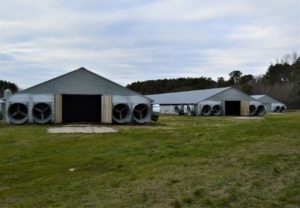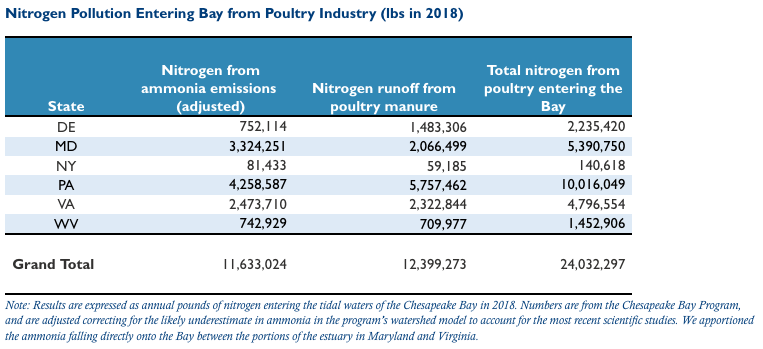
Fatter Birds and Lack of Emissions Controls Contribute 12 Million Pounds of Nitrogen to Bay Annually
Washington, D.C. — A new study, released on the 50th anniversary of Earth Day, concludes that ammonia air pollution from the Chesapeake region poultry industry contributes about 12 million pounds of nitrogen to the Bay every year, more than all the sewage and wastewater in Maryland or Pennsylvania.
The report by the nonprofit Environmental Integrity Project (EIP) uses the most recent scientific studies and federal data to show that the more than one billion chickens and turkeys grown in the Bay region every year produce about 5.7 billion pounds of manure and about 200 million pounds of ammonia emissions every year.
The fall of this air pollution back onto land and waterways, combined with the runoff of poultry manure spread on farm fields, contributes about 24 million pounds of nitrogen – the Bay’s biggest killer — to the Chesapeake every year, according to EIP’s report, “Poultry Industry Pollution in the Chesapeake Region.”
To put that number into context, that’s more than double than the roughly 10 million pounds of nitrogen pollution from all of Maryland’s sewage and wastewater plants in 2018, or the 9 million pounds from Pennsylvania’s. The 24 million pounds from poultry is even more than the 20 million pounds annually from all of the urban and suburban stormwater runoff in Virginia and Maryland combined, according to EIP’s report.
“On Earth Day, there is nothing more important than discussing the most critical environmental issues facing our world – including reducing agricultural pollution, the biggest source of contamination in the Chesapeake Bay,” said Abel Russ, Senior Attorney for the Environmental Integrity Project and co-author of the report.
“Clearly, the Chesapeake region states need to do more to reduce this major growing source of pollution, including by requiring air pollution monitoring and controls on poultry houses, and by imposing reasonable limits on permits for a new generation of super-sized factory farms,” said Russ.
Betsy Nicholas, Executive Director, Waterkeepers Chesapeake, said: “EIP’s report highlights the urgent need to address how the explosion of poultry houses has caused serious public health and environmental justice hotspots in rural communities throughout our region. Out-of-state and international corporations come in and exploit our rural communities, causing excessive pollution from air pollution from poultry houses and overapplication of manure on farm lands. Our state and federal environmental agencies need to protect our people and environment and make this stop.”
The Environmental Integrity Project’s calculation of nitrogen pollution entering the Bay from poultry industry ammonia emissions is about 14 percent, or 1.4 million pounds, higher than the total suggested by government estimates. The joint federal and state Chesapeake Bay Program, which is led by the U.S. Environmental Protection Agency, uses a computer model of pollution entering the Bay based in part on outdated studies of European broiler operations in 1980s and 1990s.
EIP’s report uses more recent numbers from studies of American poultry houses, and includes data from the most recent U.S. Department of Agriculture farm census. The report also includes case studies of how ammonia and other air pollutants from poultry operations harm the health and welfare of families living next to factory farms on the Eastern Shore of Maryland, in Accomack County, Virginia, and in York County, Pennsylvania.
Among the conclusions of EIP’s report:
- The meat chicken (or “broiler”) industry grew by about by about six percent in the Chesapeake region counties between 2007 and 2017, with 1,012,953,727 broilers sold at the beginning of that decade, and 1,073,683,072 at the end, according to estimates from the U.S. Department of Agriculture.
- However, because the industry is engineering ever-heavier birds, the amount of manure produced annually by the broiler industry in the region rose by 16 percent from 2007 to 2017.
- Of all the Bay region states, Pennsylvania experienced the largest growth, with a 19 percent rise in broilers from 2007 to 2017. York and Lebanon counties in PA had the highest growth rates, with York County rising 87 percent over this decade, and Lebanon experiencing a 73 percent growth.
- The overall growth in Maryland and Virginia was only four percent. However, there were hot spots, including Caroline County, Maryland (18 percent growth); and in Virginia’s Shenandoah Valley, where farms in Augusta County produced 45 percent more chickens and those in Rockingham 38 percent more.
Larger chickens and more poultry houses mean more waste that needs to be managed, and more ammonia rising into the atmosphere. Both can lead to increased pollution in the Chesapeake Bay.
Below is a chart summarizing the amount of nitrogen pollution entering the Bay from ammonia emissions and runoff pollution in all the Bay region states:

Kathy Phillips, Executive Director of Assateague COASTKEEPER, said: “After 35 years of formal restoration effort, 58 percent of the Bay’s waters still do not meet minimum Clean Water Act standards. On the Eastern Shore this recovery is much further behind because of the failure to adequately address farm pollution, especially from chicken manures. Nitrogen from farm lands has been reduced by only 18 percent of the required amount for this sector in Bay clean up goals. The Maryland agencies responsible for managing polluting industries need to pick up their game, and provide better transparency, monitoring, and enforcement of existing and new poultry pollution regulations.”
The Environmental Integrity Project report recommends the following policy steps to address the problem:
- All large new animal feeding operations should be required to install air pollution monitors and report their emissions on an annual basis to state environmental agencies and the EPA.
- EPA should establish safety thresholds for ammonia that apply to the fenceline areas between poultry operations and neighboring residents, to help protect local communities from excessive levels of ammonia.
- States and the EPA should require poultry houses to install effective air pollution control systems, including filters to capture particulate matter being blown by poultry house exhaust fans out into the community.
- Poultry companies should pay for the planting of more trees and forested areas around chicken houses, to protect neighbors and to help catch and reduce ammonia emissions.
- Because the Chesapeake Bay region states are already struggling with the overproduction of manure, lawmakers should impose limits on the approval of new permits for large animal feeding operations, especially in areas that produce more manure than crops can use.
- EPA should update its ammonia emission estimates from the poultry industry, used to simulate nitrogen loads to the Chesapeake Bay, to reflect the most recent available science.
Matthew Shudtz, Executive Director, Center for Progressive Reform, said: “Rural communities in the Chesapeake Bay region feed millions. The chicken they produce spreads far and wide, but the environmental costs are concentrated in a distressed watershed. For the sake of the Bay, and for the sake of everyone breathing the polluted air from these factory farms, we need to pursue the solutions EIP’s team has laid out in this report.”
Joe Jankowski, Director of the Protectors of the St. Martin River on Maryland’s Eastern Shore, said that controlling poultry pollution is important for the Atlantic Coastal Bays, as well as the Chesapeake Bay. “We feel it is inappropriate for the poultry industry to operate in a manner which causes significant harm to other industries and the citizens in the region which rely upon the Chesapeake Bay and Maryland Coastal Bays for their livelihood and recreation, and we support the recommendations in this report,” Jankowski said.
For audio of the telephone press conference on the report, click here.
To listen to our podcast on the issue, click here.
The Environmental Integrity Project is an 18-year-old nonprofit, nonpartisan organization, based in Washington D.C., dedicated to enforcing environmental laws and improving policy to protect public health and the environment.
Waterkeepers Chesapeake is a coalition of seventeen independent Waterkeeper programs working to make the waters of the Chesapeake and Coastal Bays swimmable, fishable and drinkable.
The Center for Progressive Reform is a network of more than 60 Member Scholars with a shared vision of thriving communities and a resilient planet.
The Protectors of the St Martin River is a citizens group acting to protect and improve the water quality of the Maryland Coastal Bays.
Press contact: Tom Pelton, Environmental Integrity Project, (443) 510-2574 or tpelton@environmentalintegrity.org


